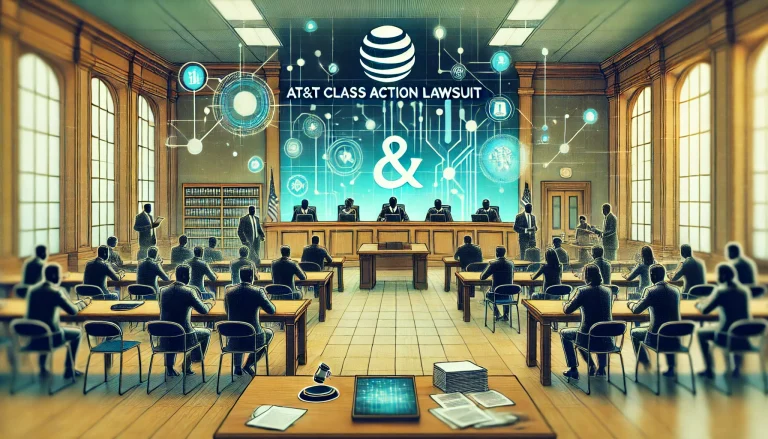The ATT class action lawsuit addresses allegations of unfair business practices affecting numerous customers. This legal action allows impacted individuals to collectively seek justice and compensation. It highlights the importance of accountability and consumer rights in corporate dealings.
What Is a Class Action Lawsuit?
A class action lawsuit is a legal process that allows a group of individuals with similar claims to file a case collectively against a defendant. This approach streamlines legal proceedings by consolidating numerous complaints into a single case.
Class action lawsuits are commonly used when large corporations are accused of wrongdoing that affects a significant number of people. Examples include consumer rights violations, workplace discrimination, or defective products.
The key advantage of a class action lawsuit is that it levels the playing field for individuals who may not have the resources to pursue individual legal claims. In this process, a representative plaintiff acts on behalf of the group.
While class actions can lead to significant settlements, not every claim qualifies. A judge must certify the group as a class, ensuring the claims share common legal and factual issues. This step is crucial to move the case forward.
Advantages of Class Actions:
- Cost-efficient for plaintiffs.
- Uniform decisions for all class members.
- Higher chances of holding corporations accountable.
Key Facts About the AT&T Class Action Case
The ATT Class Action Lawsuit centers around allegations of unfair business practices affecting a large group of customers. The case claims that the company engaged in actions such as hidden fees or misleading marketing tactics.
This lawsuit, like other class actions, represents customers with shared grievances against the company. It is designed to address violations of consumer protection laws and ensure accountability.
The case has drawn significant attention due to the scale of the alleged misconduct. Customers impacted by AT&T’s practices may be eligible to join, provided they meet specific criteria outlined by the lawsuit.
Timeline of Key Events (Hypothetical Example)
| Date | Event |
| March 2023 | Lawsuit officially filed. |
| June 2023 | Judge grants class certification. |
| December 2024 | Settlement negotiations begin. |
It’s crucial for those affected to monitor updates as the lawsuit progresses.
Allegations Made Against AT&T
The ATT Class Action Lawsuit revolves around several allegations, primarily focusing on unethical practices that harmed customers financially. These allegations typically claim that AT&T failed to provide clear terms or imposed undisclosed charges.
Some reports suggest the company may have misrepresented service plans, leading customers to pay more than expected. For instance, fees not included in original agreements might have been added to bills without adequate disclosure.
Another major claim is about misleading advertisements. Customers argue that the company failed to deliver on the promises made in marketing campaigns. This could include unfulfilled discounts or benefits.
The lawsuit also raises concerns about data privacy, alleging that customer information may have been mishandled. If proven, these practices would represent a breach of consumer trust and legal standards.
Lawsuits like this aim to rectify such violations and potentially recover damages for affected individuals.
Eligibility to Join the Lawsuit
To join the AT&T class action lawsuit, individuals must meet specific eligibility criteria. The primary condition is that the individual must have been directly impacted by the company’s alleged misconduct.
Eligibility often includes proof of being an AT&T customer during the specified time frame when the violations occurred. Documentation, such as billing statements or contracts, can help substantiate claims.
The court requires claimants to demonstrate a shared grievance with others in the class. This ensures the case focuses on common legal issues and avoids individual disputes.
Steps to Determine Eligibility
- Review the allegations to see if they align with your experience.
- Gather evidence, including communications or receipts.
- Consult legal counsel if needed for clarification.
Deadlines are critical in class actions. Potential members should act promptly to avoid missing their chance to participate.
Filing a Claim: A Step-by-Step Guide
Filing a claim in the ATT Class Action Lawsuit is a straightforward process designed to ensure all eligible members can participate.
- Receive Notification: If you’re eligible, you may receive a notification via mail or email. This document explains the claims process, deadlines, and required steps.
- Complete the Claim Form: Fill out the form provided, ensuring all details are accurate. This may include personal information, account numbers, and a description of the issue.
- Submit Documentation: Attach any supporting evidence, such as billing statements or proof of payment. This strengthens your claim and verifies eligibility.
- Monitor the Case: Stay informed about case updates, especially if the settlement includes specific instructions for receiving compensation.
The process may vary depending on how the court structures the settlement. However, timely action and accurate documentation are crucial for claimants.
Recent Developments in the Case
The ATT Class Action Lawsuit has recently seen significant legal and procedural progress. Courts have reviewed the allegations and certified the class, allowing the lawsuit to move forward. This decision ensures that affected individuals can collectively seek justice.
The discovery phase, where evidence is exchanged between parties, has brought new insights into AT&T’s practices. Reports indicate internal documents and customer complaints may play a key role in supporting the allegations.
Additionally, settlement discussions have reportedly begun. While no agreements have been finalized, these negotiations suggest that AT&T may be willing to resolve the matter outside of court.
Current Timeline of Developments:
| Date | Development |
| February 2024 | Class certification granted. |
| June 2024 | Discovery phase reveals key data. |
| January 2025 | Preliminary settlement talks begin. |
Staying informed about these updates is critical for potential class members, as new developments could affect eligibility or compensation.
Possible Outcomes of the AT&T Class Action Lawsuit
The ATT Class Action Lawsuit could result in several potential outcomes, depending on how the case unfolds. One possibility is a settlement agreement, where AT&T compensates affected individuals without admitting wrongdoing.
If the case goes to trial, a court ruling could either favor the plaintiffs or dismiss the claims. A ruling in favor of the plaintiffs may result in monetary compensation, policy changes by AT&T, or both.
Another potential outcome is a negotiated resolution before trial. In such cases, parties may agree on corrective actions, such as better transparency in billing practices.
Key Possible Outcomes
- Monetary compensation for eligible members.
- Refunds for hidden charges or overcharges.
- Policy changes to prevent future violations.
While settlements are common in class actions, it’s important for claimants to follow case updates closely to ensure they understand the resolution process.
Understanding Class Action Compensation
Compensation in class action lawsuits typically varies depending on the severity of damages and the number of claimants. In the AT&T class action lawsuit, compensation may include refunds for overcharges, reimbursement for hidden fees, or other monetary relief.
The total settlement amount is usually divided among class members based on the extent of their individual claims. Members who provide thorough documentation of losses may receive higher payouts.
Sometimes, non-monetary benefits are included, such as service credits or discounts. This approach ensures affected customers are compensated even if direct cash payments are limited.
Example Compensation Breakdown
| Type of Compensation | Example Amount (Hypothetical) |
| Refund for hidden fees | $50-$100 per customer |
| Service credits | $25 monthly for six months |
| Additional reimbursement | Based on documented claims |
Understanding how compensation is distributed helps class members set realistic expectations for what they may receive.
Legal Strategies Used in the AT&T Lawsuit
The legal strategies in the ATT Class Action Lawsuit focus on proving that the company engaged in practices that violated consumer protection laws. Attorneys for the plaintiffs rely on evidence such as internal documents, customer complaints, and expert testimony to build a strong case.
One key strategy involves demonstrating that AT&T failed to disclose hidden charges, which is a violation of transparency regulations. Lawyers may also argue that the company’s marketing was misleading, emphasizing how promises made in advertisements were not honored.
Additionally, the plaintiffs’ legal team may compare AT&T’s practices to industry standards. This can help highlight deviations that suggest intentional misconduct.
Common Strategies in Class Actions:
- Emphasizing patterns of behavior across multiple customers.
- Presenting evidence of financial harm to claimants.
- Highlighting discrepancies between marketing promises and actual services provided.
These legal approaches aim to ensure accountability and fair resolution for all affected parties.
The Impact of Class Action Cases on Consumers
Class action lawsuits provide consumers with a powerful tool to hold corporations accountable. By combining similar claims into one case, individuals who may not have the resources to pursue individual lawsuits can collectively seek justice.
One significant impact is financial restitution. Many class actions, including cases like the AT&T lawsuit, often result in monetary compensation for affected consumers. These funds help recover losses caused by unethical corporate behavior.
Class actions also promote better business practices. Companies faced with large lawsuits often reassess their policies and implement changes to avoid future legal troubles. This can lead to improved transparency and consumer protections.
Benefits to Consumers in Class Actions
- Equal representation in legal disputes.
- Greater access to justice for smaller claims.
- Encouragement of corporate accountability.
However, some critics argue that settlements may not always provide substantial payouts to individual class members, as funds are divided among a large group.
How Deadlines Shape Class Action Proceedings
Deadlines play a critical role in the success of class action lawsuits, influencing every stage of the legal process. One of the first deadlines is for filing the lawsuit itself, ensuring that claims are submitted within the statute of limitations.
Potential class members must also adhere to opt-in or opt-out deadlines. Missing these can disqualify individuals from receiving compensation or being part of the lawsuit.
For defendants, deadlines govern the submission of evidence and legal arguments. Failure to meet these requirements can weaken their position in the case.
Impact of Deadlines in Class Actions
| Type of Deadline | Significance |
| Filing the lawsuit | Ensures timely submission within the law. |
| Opt-in/Opt-out | Determines who can participate. |
| Evidence submission | Impacts the strength of each party’s case. |
Overall, adhering to deadlines ensures a fair and efficient legal process for all parties involved.
Insights From Similar Cases in the Industry
Class action lawsuits against large corporations like AT&T are not uncommon, offering valuable insights into how such cases unfold. For instance, similar lawsuits in the telecommunications industry often highlight patterns of billing discrepancies or service-related grievances.
A notable example is a case involving another major telecom provider that faced allegations of overcharging customers through hidden fees. That lawsuit resulted in a multi-million-dollar settlement and stricter billing practices.
In many instances, these cases emphasize the importance of consumer awareness. Customers are often unaware of the fine print in contracts or billing statements, which can lead to legal disputes.
Key Lessons from Similar Cases
- Clear communication is crucial to avoid legal challenges.
- Companies often settle to mitigate reputational damage.
- Consumer vigilance can help prevent recurring issues.
Learning from these examples provides a broader perspective on how the ATT class action lawsuit may progress and what outcomes can be anticipated.
What to Expect After the AT&T Case Is Settled
After the AT&T class action lawsuit is settled, affected consumers can expect a series of procedural steps to finalize compensation. Settlements often involve detailed plans outlining how payments or refunds will be distributed.
Class members may receive notifications detailing the settlement terms. These communications typically include instructions for claiming compensation and deadlines for submission.
Settlement agreements sometimes result in non-monetary benefits, such as policy changes or service credits. These measures are intended to prevent future disputes and improve customer satisfaction.
Example Post-Settlement Timeline:
| Step | Timeframe |
| Settlement Approval | 1-3 months after agreement. |
| Claims Submission Period | 3-6 months for class members. |
| Distribution of Funds | 6-12 months post-approval. |
While the process may take time, staying informed ensures class members don’t miss out on their entitlements.
Conclusion
Class action lawsuits, such as the ATT case, serve as a vital mechanism for ensuring corporate accountability and providing justice for consumers. They allow individuals with shared grievances to collectively address issues that may otherwise go unresolved in individual claims.
The ATT class action lawsuit underscores the importance of transparency and ethical business practices. It highlights how legal action can not only compensate affected individuals but also drive systemic changes within industries, ultimately benefiting all consumers.
FAQs
What is the purpose of a class action lawsuit?
It allows a group of people with similar claims to collectively seek justice against a defendant.
How do I know if I’m eligible to join the AT&T class action lawsuit?
You must have been directly impacted by the company’s alleged misconduct during the specified time.
What compensation can I expect from a class action lawsuit?
Compensation may include refunds, reimbursements, or non-monetary benefits like service credits.
How long does it take for a class action lawsuit to be resolved?
It can take months to years, depending on the complexity of the case and settlement negotiations.
Can I opt out of a class action lawsuit?
Yes, but you must meet the opt-out deadline to preserve your right to file an individual lawsuit.
Article Recommendations
Sheetz Lawsuit Background Checks Debate: Are Blanket Hiring Policies Putting Companies at Risk?
UWM Lawsuit 2024: Why the Mortgage Industry Is Watching These Legal Cases Closely
Sparta Mesothelioma Legal Question: Exploring Compensation, Lawsuits, and Asbestos Trust Funds




